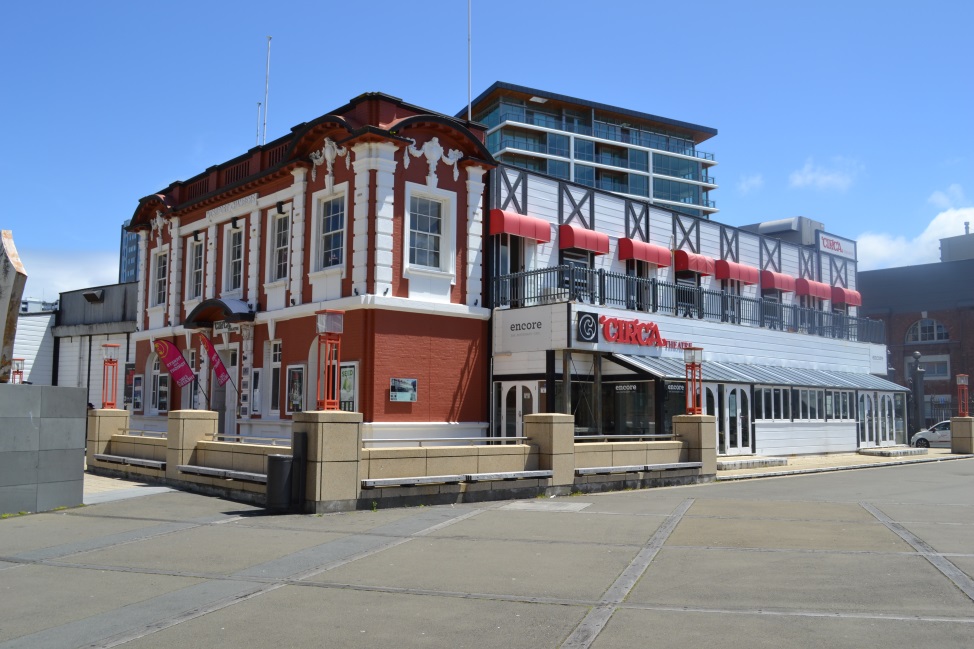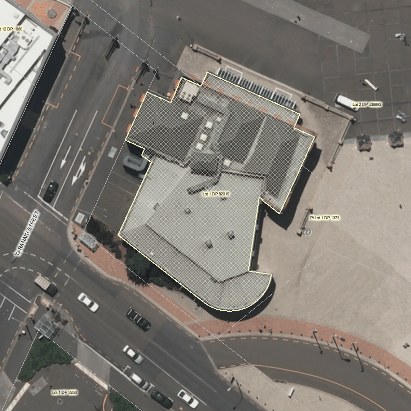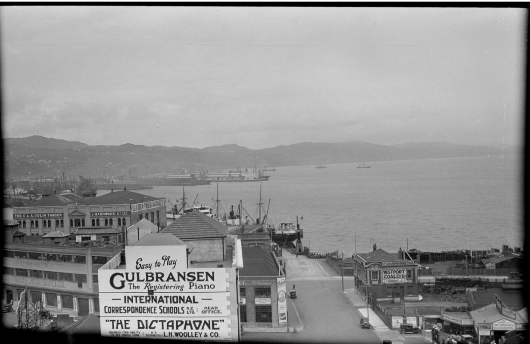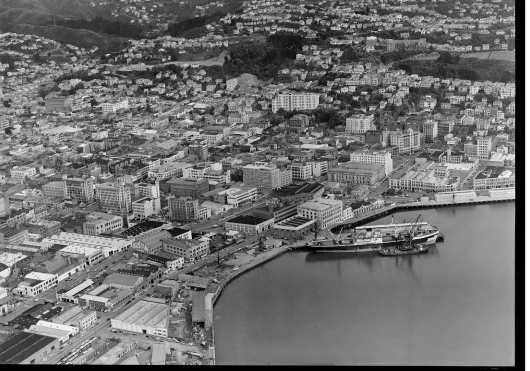Circa Theatre




c.1929 - the Westport Coal Company building in its original location at the corner of Taranaki Street and Cable Street.
National Library Reference: "Wellington city scene including the intersection of Taranaki and Cable Streets. Just, F R :Two albums of photographs and captions relating to the Just family and 119 negatives taken by his father in the 1920s and 1930s of around Wellington and the Bell Bus Company. Ref: 1/2-071478-F. Alexander Turnbull Library, Wellington, New Zealand. http://natlib.govt.nz/records/23117809 "

1956 - The Westport Coal Company building in its original location at the intersection of Cable Street and Taranaki Street.
National Library reference: "Wellington Harbour southern wharf area with Cable and Taranaki Streets and city, with Kelburn Park and Victoria University, Wellington City. Whites Aviation Ltd :Photographs. Ref: WA-40792-G. Alexander Turnbull Library, Wellington, New Zealand. http://natlib.govt.nz/records/30113905 "
-
Constructed
1916 - 1916
-
-
Architect(s)
-
Builder(s)
W H Bennett
-
The well-proportioned, elaborately detailed brick masonry facades of the former Westport Coal Company building were moved here in 1994.
The Westport Coal Company was once New Zealand’s largest coal producer and supplier.
-
Downloadable(s)
-
close
History
-
The Westport Coal Company was founded in 1881 when a group of Dunedin businessmen purchased the mines of the Westport Colliery Company Ltd. The company developed the remote West Coast coalfields at Coalbrookdale (Denniston) and Granity Creek (Millerton) and was once New Zealand’s largest coal producer. It had a head office in Dunedin with depots in most cities and large towns throughout New Zealand. The Union Steam Ship Company was a major shareholder and customer, and by strategic asset acquisition, held a virtual monopoly of West Coast coal until the intervention of Richard Seddon’s government in 1901 with the establishment of the State Coal Mines.
The Westport Coal Company traded from premises at Queen’s Chambers, Post Office Square, with branches on Dixon Street, Tinakori-road and Tasman Streets until 1915 when a site was purchased on the ‘Taranaki-street extension’. They commissioned architects Penty and Lawrence to design a two storey brick building with a manager’s office at ground floor and a showroom on the first floor levels. The new premises were said to be ‘a fine building’ located on a site near Te Aro Station that had previously been used by travelling circuses. The elevations were of ‘red brick relieved with white stucco facings’, the ceilings were of pressed metal with rimu panelling and plastered walls. The rear yard was fitted with a ‘self-recording weigh bridge and the total cost of construction was approximately £3000.
The Westport Coal company went into a decline in the 1930s due in part to the displacement of coal by oil fuel and hydroelectric power, as well as reductions in the country’s rail service and by a reduction in demand for coal in industry caused by the economic depression. The outbreak of war in 1939 led to a strong demand for coal. Coal mining was declared an essential industry in 1942, and all the mines in the Grey River valley were nationalised in that year. In 1948 the nation’s remaining coal deposits were nationalised and the Westport Coal Company was either nationalised or ceased to trade at around this time.
The building was substantially demolished in the early 1990s and the street facades were moved across Cable Street to the north east of the Cable and Taranaki Street intersection. These were incorporated in the new Circa Theatre building, designed by Ampersand architects and theatre consultant Grant Tilly that opened in 1994. The original street façade was rotated 180-degrees to face the plaza in front of the Museum of New Zealand (Te Papa Tongarewa) that was under construction at the time.
The original Taranaki Street façade and a single bay of the north (Cable Street) and south (coal yard) facades now form the main entrance to the theatre. The remaining walls of the new theatre are clad in weatherboards and decorated to resemble the nearby Wellington Rowing Club Building (c.1906). The new Circa Theatre building is an unusual agglomeration of shapes, masses, building styles and materials, and the old Westport Company building is somewhat overwhelmed by the scale and architecture of the new elements. The new Circa Theatre has its critics in among the architectural community and was selected as one of Wellington’s top-ten ‘worst buildings’ in a competition run by Wellington’s Architecture Centre in 2007.
-
Modifications
close
-
1916 - 1916
-
Constructed
-
1994 - 1994
-
Demolition (facades retained and relocated)
-
-
Occupation History
close
Not assessed
-
-
close
Architectural Information
-
Building Classification(s)
close
Not assessed
-
Architecture
close
The Westport Coal Company building was substantially demolished in 1994 and the only remaining elements include the main (west) façade that once faced Taranaki Street, and a single bay each of the facades that once faced north (Cable Street) and south (to the coal yards).
The building fragment was rotated 180-degrees and relocated to a new site on the north-east corner of the Cable and Taranaki Street intersection. It was incorporated as the main entrance of the new Circa Theatre building in 1994. The design of the new Circa Theatre building is somewhat controversial and the remaining fragment old Westport Coal Company building is somewhat overwhelmed by the scale and architecture of the new elements.
-
Materials
close
Brick masonry with rendered decorative elements
-
Setting
close
The building fragment has been relocated to an adjacent site within the redeveloped Wellington waterfront. The façade has been rotated to address the public plaza by the main entrance of the Museum of New Zealand Te Papa Tongarewa.
-
Building Classification(s)
close
-
close
Cultural Value
The remaining fragment of the former Westport Coal Company building has some architectural value for its well proportioned and elaborately detailed brick masonry facades. The aesthetic value has been somewhat diminished its incorporation into the new Circa Theatre building that is considered to have little architectural merit by many in the local architectural community.
The fragment of the 1916 masonry building has some historic value for its association with the Westport Coal Company that was once the nation’s largest coal producer and supplier. This has been somewhat diminished by the demolition of the building and relocation of the facades in 1994.
-
Aesthetic Value
close
-
Architectural
Does the item have architectural or artistic value for characteristics that may include its design, style, era, form, scale, materials, colour, texture, patina of age, quality of space, craftsmanship, smells, and sounds?
The remaining fragment of the former Westport Coal Company building has some architectural value for its well proportioned and elaborately detailed brick masonry facades. The aesthetic value has been somewhat diminished its incorporation into the new Circa Theatre building that is considered to have little architectural merit by many in the local architectural community.
-
Townscape
Does the item have townscape value for the part it plays in defining a space or street; providing visual interest; its role as a landmark; or the contribution it makes to the character and sense of place of Wellington?
Circa Theatre has some townscape value for its integration into the public space in front of Te Papa Tongarewa (Museum of New Zealand).
-
-
Historic Value
close
-
Association
Is the item associated with an important person, group, or organisation?
The fragment of the 1916 masonry building has some historic value for its association with the Westport Coal Company that was once the nation’s largest coal producer and supplier. This has been somewhat diminished by the demolition of the building and relocation of the facades in 1994.
-
- Scientific Value close
-
Social Value
close
Not assessed
- Level of Cultural Heritage Significance close
-
Local / Regional / National / International Importance
close
Not assessed
-
Aesthetic Value
close
-
close
Site Detail
-
District Plan Number
17/408 (Street facades of the former Westport Coal Company only)
-
Legal Description
Lot 1 DP82019
-
Heritage New Zealand Listed
Not listed
-
Archaeological Site
Central City NZAA R27/270 – & reclaimed land
-
Current Uses
unknown
-
Former Uses
unknown
-
Has building been funded
No
-
Funding Amount
Not applicable
-
Earthquake Prone Status
To be assessed
-
-
close
Additional Information
-
Sources
close
- ‘History’, Circa Theatre website accessed July 2016
- The Cyclopedia of New Zealand [Otago & Southland Provincial Districts] (Christchurch: The Cyclopedia Company, Limited, 1905)
- DEATHS. Dominion, 19 April 1919, Page 1
- WESTPORT COAL CO.'S NEW OFFICES Evening Post, 9 August 1916, Page 2
- LOCAL AND GENERAL Evening Post, 2 November 1915, Page 6
- MR. C. A. LAWRENCE Evening Post, 30 January 1933, Page 11
- BUSINESS DECLINE Evening Post, 24 November 1931, Page 12
- Just, F R ‘Wellington city scene including the intersection of Taranaki and Cable Streets: Two albums of photographs and captions relating to the Just family and 119 negatives taken by his father in the 1920s and 1930s of around Wellington and the Bell Bus Company.’ Ref: 1/2-071478-F. Alexander Turnbull Library, Wellington, New Zealand.
- 'Coal is discovered - Seddonville'. Ministry for Culture and Heritage. Updated 20-Dec-2012
- Sherwood, Alan and Jock Phillips. 'Coal and coal mining - The 19th century', Te Ara - the Encyclopedia of New Zealand, updated 13-Jul-12
- Alan Sherwood and Jock Phillips. 'Coal and coal mining - The 20th century', Te Ara - the Encyclopedia of New Zealand, updated 13-Jul-12
- Thomson, Rebecca. ‘Centre Stage for 35 years’ Dompost, 14/04/2011.
- Wellington Architecture Centre website updated 12th March 2007
- WCC Heritage Inventory 2001 ref Appendix III
- Technical Documentation close
-
Footnotes
close
Not available
-
Sources
close
Last updated: 11/24/2016 3:12:16 AM
